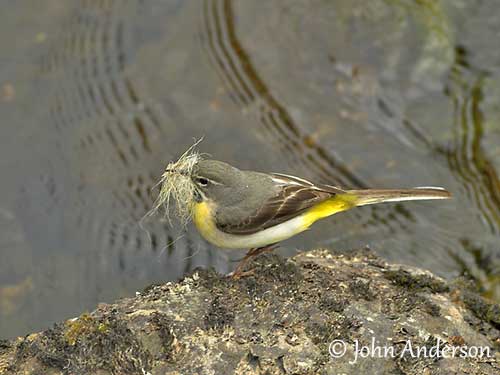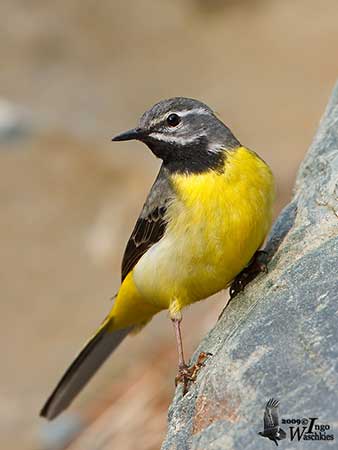
The female lays 4-6 glossy, creamy-coloured eggs with grey-buff spots. Both adults incubate during 11-13 days, but the female does most of the work. The chicks are fed by their parents at nest during 12-13 days, and for 2-3 weeks after fledging. The male alone may feed them if the female starts a new brood.
If the nest is threatened, the adult performs distraction-display, usually feigning an injury.
PROTECTION / THREATS / STATUS:
The Grey Wagtail is mainly affected by severe winters involving frozen waters and reduction of food resources.
The European breeding population was estimated to number 1,380,000/3,960,000 mature individuals in 2015.
Europe forms 20% of the global range. The global population is roughly estimated at 6,900,000/19,800,000 mature individuals. This population is suspected to be stable.
The Grey Wagtail is not considered globally threatened and the species is currently evaluated as Least Concern.
Fr: Bergeronnette des ruisseaux
Ang: Grey Wagtail or Gray Wagtail
All: Gebirgsstelze
Esp: Lavandera Cascadeña
Ita: Ballerina gialla
Nd: Grote Gele Kwikstaart
Sd: forsärla
Photographers:
John Anderson
John Anderson Photo Galleries
Steve Garvie
RAINBIRDER Photo galleries
Ken Havard
My Bird Gallery & Flickr gallery 1 & Flickr gallery 2
Jean-Claude Jamoulle
A la rencontre des Oiseaux
Alan & Ann Tate
AA Bird Photography
Ingo Waschkies
Bird Photography
Text by Nicole Bouglouan
Sources:
HANDBOOK OF THE BIRDS OF THE WORLD Vol 9 - by Josep del Hoyo - Andrew Elliot - David Christie - Lynx Edicions - ISBN: 8487334695
THE COMPLETE BOOK OF BRITISH BIRDS – Written by “Royal Society for the Protection of Birds” experts - Préface de Magnus Magnusson - Michael Cady- Rob Hume Editors - ISBN: 0749509112
THE HANDBOOK OF BIRD IDENTIFICATION FOR EUROPE AND THE WESTERN PALEARCTIC by Mark Beaman, Steve Madge - C. Helm - ISBN: 0713639601
ENCYCLOPEDIE DES OISEAUX DE FRANCE ET D’EUROPE – de Peter Hayman et Rob Hume - Flammarion – ISBN : 2082009920
Breeding Biology of the Grey Wagtail
Birds of Britain - The Web Magazine for Birdwatchers
Thaï National Parks
Wikipedia, the free encyclopaedia
Grey Wagtail
Motacilla cinerea
Passeriformes Order – Motacillidae Family
INTRODUCTION:
The Grey Wagtail has long, black-and-white tail, longer than in other wagtails, but like in all species, it is continuously wagged.
This species is widely distributed across the Palearctic Region and the northern European populations usually move to southern Europe and North Africa after breeding. At this period, it can be found in lowlands, including coasts and estuaries.
The Grey Wagtail breeds near fast-flowing streams and waterfalls, lakes and canals. It builds the nest in crevices or hollows with plant material.
It feeds on various insects caught near water, but it may take sometimes water snails and tadpoles.
The Grey Wagtail is mainly affected by severe winters involving frozen waters and reduction of food. But the population is currently stable and not globally threatened.

DESCRIPTION OF THE BIRD:
Biometrics:
Length: 18-19 cm
Weight: M: 15-22 g – F: 14-20 g
The Grey Wagtail has slim body and shows little plumage variations.
The male in breeding plumage has grey upperparts with olive-yellow rump and uppertail-coverts. On the upperwing, the coverts are olive-grey, whereas the flight-feathers are black with white edges on the inner remiges. On the long, black tail, the three outer rectrices are white.
The underparts are bright yellow except the black chin and throat. On the grey underwing, the flight-feathers have white bases.
On the grey head, the male has narrow, white supercilium and broken eyering, but the lores are black. A white moustachial stripe contrasts with the black chin and throat.
The bill is black. The eyes are dark brown. Legs and feet are pinkish, but all other wagtails have black legs and feet.
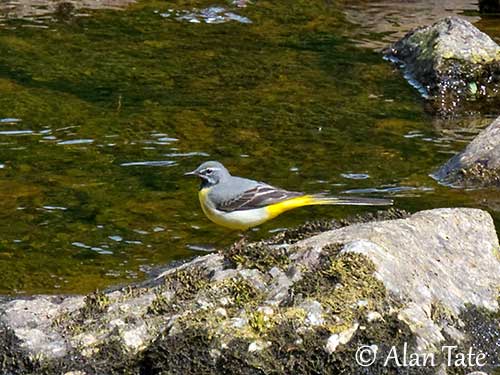
In non-breeding plumage, the male has mostly white to buffy chin and throat, and buffy supercilium.
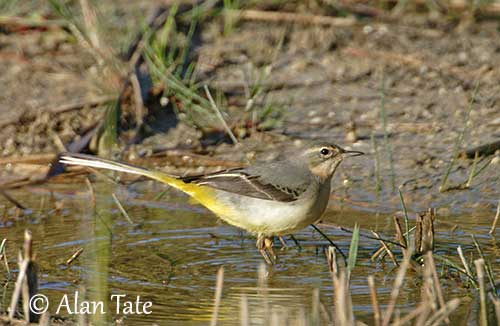
The female in breeding plumage has buffy-white, mottled black chin and throat, but sometimes all black.
In non-breeding plumage, she has paler yellow underparts and more buff on breast.
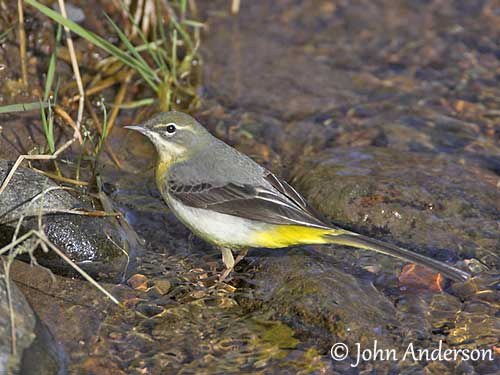
The juvenile resembles non-breeding female, but the pale markings are more buff whereas the dark markings are more olive.
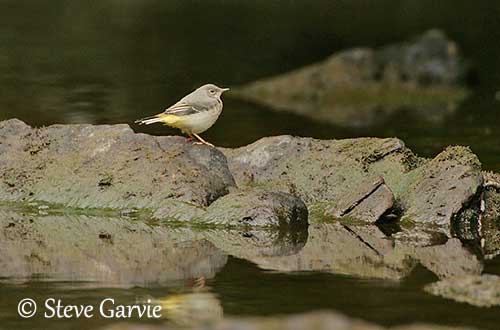
SUBSPECIES AND RANGE:
The Grey Wagtail has three subspecies currently recognized.
M.c. cinerea (described above) breeds in Eurasia from Canary Islands, Europe and North Africa, E to Siberia and Japan.
It winters to N and E Africa, S Asia and SE Asia.
M.c. patriciae is found in Azores (Furnas, Sao Miguel).
This race is paler grey above.
M.c. schmitzi is found in Madeira.
This one has more contrasted plumage and the white supercilium is less conspicuous than in nominate. Flanks are pale grey.
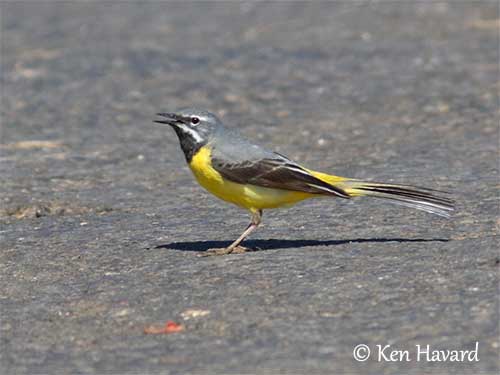
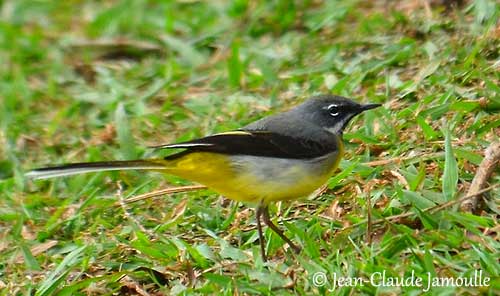
HABITAT:
The Grey Wagtail breeds near fast-flowing streams and rivers both in wooded and in open country, but mainly in hilly and mountainous areas. It breeds up to 4,100 metres of elevation in Himalayas.
Outside breeding season, it frequents a variety of habitats and descends or migrates to lowlands where it can be seen on coasts and in estuaries, sewage farms, forest tracks, farmyards and occasionally towns.
CALLS AND SONGS: SOUNDS BY XENO-CANTO
The Grey Wagtail gives a hard, abrupt “tzip” usually repeated in series ending in trill “tzii-tz-tzi-tzi-tzee-ree-ree-ree”. This call is given during the male’s parachute flight performed during the displays.
The alarm call is a rising “sueet” and when the bird is alarmed or anxious, it utters a shivering “ziss-sis-sis-sis-is”.
The song is a series of thin, trilled, melodious phrases interspersed with shivering call notes. The song is given from perch but also during a fluttering flight over streams.
BEHAVIOUR IN THE WILD:
The Grey Wagtail feeds on various aquatic invertebrates such as adult flies, mayflies, beetles, crustaceans and molluscs.
It forages by walking and picking, running or flying up a short distance to catch insects. It also performs sallies from perch out over water while flycatching, but it picks aquatic prey by wading in shallow water too.
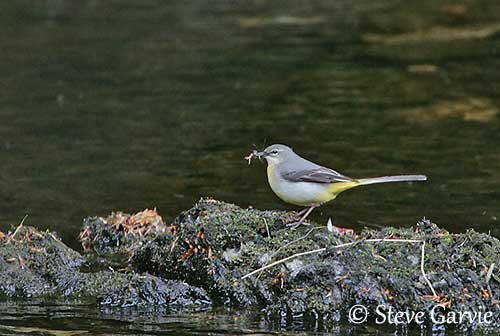
The Grey Wagtail is often observed perched on rocks and overhanging trees near streams and rivers. It also feeds on the ground by running quickly and pumping the tail up and down when stopping. The longer tail of this species accentuates the vertical wagging motion.
During winter, they usually roost in small groups.
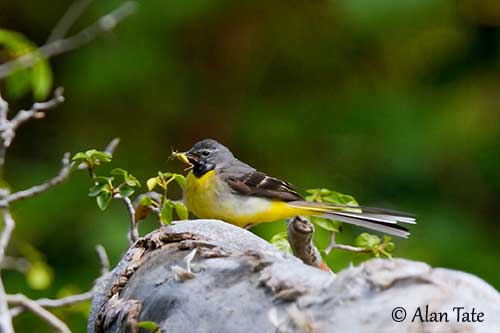
This species is monogamous and highly territorial during the breeding season. The male performs aerial displays including a short flight up to the air followed by a slow descent with a “parachute-flight”. While descending in flight, the rump feathers are puffed out, the long tail is depressed and the spread wings are lowered. These displays are accompanied by rapid series of chipping, high-pitched notes.
The Grey Wagtail nests in crevices in riverbanks or on rock ledge, on ledge in wall or under bridge. Both adults share the nesting duties.
The Grey Wagtail of nominate race spends the winter in the southern parts of the breeding range and in North Africa, whereas the eastern populations migrate to NE Africa and S and SE Asia.
Some movements after breeding are related to food availability.
They leave the breeding areas from August, but often not until October. They return in March/May.
The flight of the Grey Wagtail is strongly bounding and the very long tail is conspicuous.
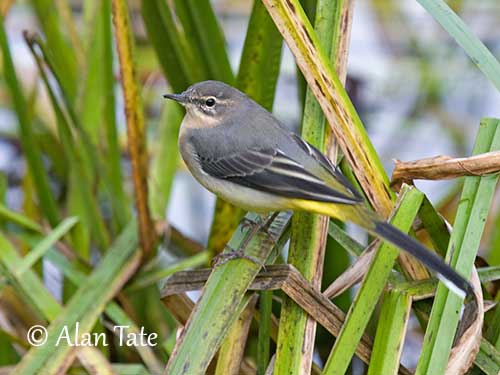
REPRODUCTION OF THIS SPECIES:
The breeding season occurs between late March-April and August in Europe, in late March to May in North Africa, and in early March to June in Canary Islands. The laying occurs from late May in Azores and from late April to early July in N Indian Subcontinent.
The Grey Wagtail produces two broods per season, and occasionally three.
Both adults take part in nest-building. The nest is often built in hollows or crevices with twigs, grass and moss. This is a platform with a cup in the centre, lined with finer grasses, vegetal fibres and horse hair. It can be built on rock ledge or on ledge on wall, or under bridge, but usually near running water.
